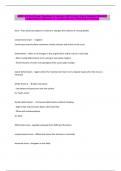-
1. Exam (elaborations) - Apsc 151 exam | questions & answers (100 %score) latest updated 2024/2025 comprehensi...
-
2. Exam (elaborations) - Apsc 151 final exam | questions & answers (100 %score) latest updated 2024/2025 compr...
-
3. Exam (elaborations) - Apsc 151 final exam | questions & answers (100 %score) latest updated 2024/2025 compr...
-
4. Exam (elaborations) - Apsc 151 final exam | questions & answers (100 %score) latest updated 2024/2025 compr...
-
5. Exam (elaborations) - Apsc 151 final exam | questions & answers (100 %score) latest updated 2024/2025 compr...
-
6. Exam (elaborations) - Apsc 151 final exam | questions & answers (100 %score) latest updated 2024/2025 compr...
-
7. Exam (elaborations) - Apsc 151 final exam prep | questions & answers (100 %score) latest updated 2024/2025 ...
-
8. Exam (elaborations) - Apsc 151 final exam | questions & answers (100 %score) latest updated 2024/2025 compr...
-
9. Exam (elaborations) - Apsc 151 geology final exam | questions & answers (100 %score) latest updated 2024/20...
-
10. Exam (elaborations) - Apsc 151 groundwater exam | questions & answers (100 %score) latest updated 2024/2025...
-
11. Exam (elaborations) - Apsc 151 metamorphic rocks | questions & answers (100 %score) latest updated 2024/202...
-
12. Exam (elaborations) - Apsc 151 midterm exam | questions & answers (100 %score) latest updated 2024/2025 com...
-
13. Exam (elaborations) - Apsc 151 midterm exam | questions & answers (100 %score) latest updated 2024/2025 com...
-
14. Exam (elaborations) - Apsc 151 midterm exam | questions & answers (100 %score) latest updated 2024/2025 com...
-
15. Exam (elaborations) - Apsc 151 midterm pt 2 | questions & answers (100 %score) latest updated 2024/2025 com...
-
16. Exam (elaborations) - Apsc 151 midterm questions | questions & answers (100 %score) latest updated 2024/202...
-
17. Exam (elaborations) - Apsc 151 midterm review | questions & answers (100 %score) latest updated 2024/2025 c...
-
18. Exam (elaborations) - Apsc 151 midterm study guide | questions & answers (100 %score) latest updated 2024/2...
-
19. Exam (elaborations) - Apsc 151 minerals exam | questions & answers (100 %score) latest updated 2024/2025 co...
-
20. Exam (elaborations) - Apsc 151 tectonics exam | questions & answers (100 %score) latest updated 2024/2025 c...
-
21. Exam (elaborations) - Apsc 151 terms | questions & answers (100 %score) latest updated 2024/2025 comprehens...
-
22. Exam (elaborations) - Apsc 151 terms/concepts | questions & answers (100 %score) latest updated 2024/2025 c...
-
23. Exam (elaborations) - Apsc 151 test | questions & answers (100 %score) latest updated 2024/2025 comprehensi...
-
24. Exam (elaborations) - Apsc 151 week 1 exam | questions & answers (100 %score) latest updated 2024/2025 comp...
-
25. Exam (elaborations) - Apsc 151 week 2-surface and crust dynamics, secondary materials exam | questions & an...
-
26. Exam (elaborations) - Apsc 151 week 3 -hazard management and earth systems engineering exam | questions & a...
-
27. Exam (elaborations) - Apsc 151 week 4 earth resources | questions & answers (100 %score) latest updated 202...
-
28. Exam (elaborations) - Apsc 151 week 5 | questions & answers (100 %score) latest updated 2024/2025 comprehen...
-
29. Exam (elaborations) - Apsc 151 week 7/8 | questions & answers (100 %score) latest updated 2024/2025 compreh...
-
30. Exam (elaborations) - Apsc 151 week 8 | questions & answers (100 %score) latest updated 2024/2025 comprehen...
-
31. Exam (elaborations) - Apsc 151 week 9/10 | questions & answers (100 %score) latest updated 2024/2025 compre...
-
32. Exam (elaborations) - Apsc 151 week 11 exam | questions & answers (100 %score) latest updated 2024/2025 com...
-
33. Exam (elaborations) - Apsc 151- life exam | questions & answers (100 %score) latest updated 2024/2025 compr...
-
34. Exam (elaborations) - Apsc 151- glaciation exam | questions & answers (100 %score) latest updated 2024/2025...
-
35. Exam (elaborations) - Apsc 151- erosion exam | questions & answers (100 %score) latest updated 2024/2025 co...
-
36. Exam (elaborations) - Apsc 151- geophysical exploration | questions & answers (100 %score) latest updated 2...
-
37. Exam (elaborations) - Apsc 151- geotechnical engineering | questions & answers (100 %score) latest updated ...
-
38. Exam (elaborations) - Apsc 151: geology of the solar system exam | questions & answers (100 %score) latest ...
-
39. Exam (elaborations) - Apsc151 exam | questions & answers (100 %score) latest updated 2024/2025 comprehensiv...
-
40. Exam (elaborations) - Apsc151 midterm exam | questions & answers (100 %score) latest updated 2024/2025 comp...
-
41. Exam (elaborations) - Apsc151 mining exam | questions & answers (100 %score) latest updated 2024/2025 compr...
-
42. Exam (elaborations) - Earth science apsc 151 | questions & answers (100 %score) latest updated 2024/2025 co...
-
43. Exam (elaborations) - Week 2 apsc 151 | questions & answers (100 %score) latest updated 2024/2025 comprehen...
-
44. Exam (elaborations) - Apsc 151 2024 final exam | questions & answers (100 %score) latest updated 2024/2025 ...
-
45. Exam (elaborations) - Apsc 151 2024 geology midterm exam | questions & answers (100 %score) latest updated ...
-
46. Exam (elaborations) - Apsc 151 exam- engineering geology and the biosphere | questions & answers (100 %scor...
-
47. Exam (elaborations) - Apsc 151 exam | questions & answers (100 %score) latest updated 2024/2025 comprehensi...
-
48. Exam (elaborations) - Apsc 151 exam | questions & answers (100 %score) latest updated 2024/2025 comprehensi...
-
49. Exam (elaborations) - Apsc 151 exam prep | questions & answers (100 %score) latest updated 2024/2025 compre...
-
Show more




